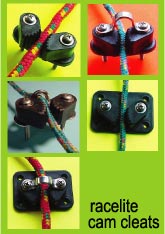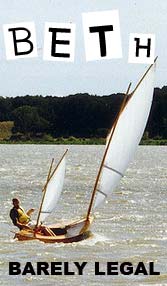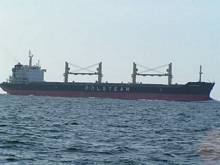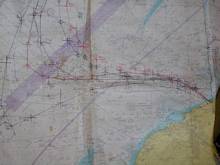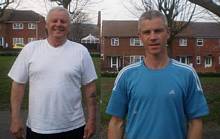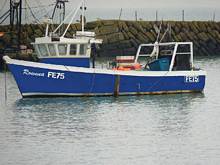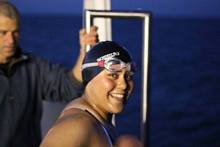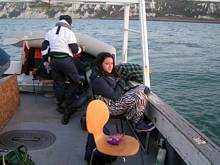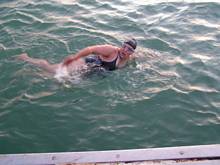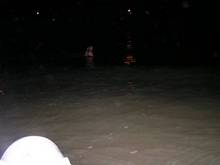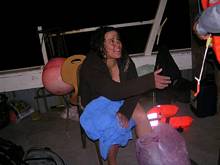Having read my last article “Dinghy on a budget – Part 1” you were no doubt expecting this to be part 2, as was I. However, its part of life’s rich tapestry that things never turn out as expected, and a good thing too, as that unexpected element keeps us on our toes and prevents boredom setting in. Some time ago my niece Davinia announced her intention to swim across the English Channel in order to raise funds for charity, recently she asked me to help out on the boat, as I had the time available. As the sponsorship was for a charity I support RNLI (Royal National Lifeboat Institute) I decided to write an article on the event, but first a little bit of background…
The distance between Dover and Calais is 20 miles direct but allowing for tidal drift the distance is more like 30 miles. The first swim across the channel was made between by Mathew Webb in 1875 in 21 hours 45 minutes, since this initial swim times have gotten faster with better training methods, nutrition and planning, culminating in average times of 12 hours and some swims of under 9 hours. Over the years channel swimming has become organised and regulated, which is the natural trend for most aspects of our lives. The CSA (Channel Swimming Association) was formed in 1922 to regulate the sport, in 1999 it became the CSA Ltd. As with most things politics rears its ugly head, and we now have a rival body in the CS&PF (Channel Swimming & Piloting Association) founded in 2000 by a splinter group. From what I can gather there seems to be some animosity between them, so best not delve further. The route is across one of the busiest shipping lanes in the world and the neighbours can be big and ugly.
Logistics
The swim was dependant on a number of factors, the first of these being the combination of weather and tide, although fast swims have been done on spring tides it needs settled weather otherwise the water can be very choppy making swimming difficult. Our tide window was the neap tides between 20th to 23rd September. Most swims start 1.5 hours before high tide and aim to swim during the daylight hours, so these factors gave our start time, all we needed was the right day.
Dover Tides
Date |
High Water BST |
Height in meters |
Start time |
Tue 20 Sep 2011 |
03:46am |
5.68 |
02:16 |
Wed 21 Sep |
04:53am |
5.35 |
04:23 |
Thu 22 Sep |
06:31am |
5.2 |
05:01 |
Fri 23 Sep |
08:05am |
5.41 |
06:35 |
|
The route is second from the right in black circles, sorry the final part is cut off but photographic conditions were far from ideal. |
Trying to get one boat with crew, an official observer, 4 support staff and one swimmer together at the right time and place is not an easy task, particularly when some of them are travelling several hundred miles to be there, and the exact date dependant on the whether. As it was we started the swim on the Friday 23rd September at 6:10am and had one of the most perfect days of the year, with calm conditions and sun filtering through thin clouds. There was no official observer available so the skippers son, who was qualified in this respect, took that role.
Now for a quick word about our recipient charities RNLI and Rapid.
RNLI
The RNLI (Royal National Lifeboat Institute) was formed in 1824 with the aim of saving lives at sea from ship wrecks, in 1854 Queen Victoria gave it its Royal status. It also has my patronage, being a sailor I try to look after my own interests when out on a dark and possibly stormy night. At present the institution has some 440 lifeboats in 235 stations round the British Isles, saving on average 20 people per day. It is manned by volunteers and funded mostly from charitable donations, although there has been a recent trend for local councils to pay RNLI lifeguards for beach support in their area. Being a charitable institution brings the bonus of not having to put red tape and bureaucracy before the job in hand, but it also brings the responsibility of having to raise its own funding, this is where people like Davinia with the sponsored swim come in, and myself with an annual payment, this is one of the most worthwhile and tangible charities I know, although they try to maintain a high profile to fund the important service they offer, more income is always welcome.
Rapid
Rescue And Preparedness In Disaster was formed in 1996 as a charity to provide disaster aid on a worldwide basis. It is a UK based charity that has even deployed here to provide flood and building collapse aid. Not having governmental funding it relies on charitable donations and currently spends over half of its effort on training where it has previously deployed, to mitigate against future disasters.
We were very fortunate in our choice of skipper. Peter Reed and his son Peter Reed Junior were a perfect team, helpful on any point they could be. Unlike some skippers I had heard of, the two of them anticipated our every need, explained everything we were unsure of and kept a very welcome kettle boiling to provide us with hot water to keep our swimmer going.
|
Our boat ‘Rowena’ a typical channel fishing vessel, no frills just tough and capable. |
Peter Reed senior.
I asked Peter how he got started in this business. “I started escorting swimmers across the channel about 20 years ago with my father, there was no bureaucracy in those days all you needed was a boat. Now it’s a lot different and a lot more expensive.” At this point he gave me a list of the requirements which included a life raft to be serviced every 2 years, training for each member of the crew, extra insurance, extra flares, regular boat survey…, my eyes were beginning to glaze over as bureaucracy is my pet hate “…not to mention all the extra electronic equipment, AIS, radar, …” I rapidly changed the subject “So you have been doing it ever since?” “Oh no” he replied “Fishing was good in those days so we concentrated on that and only last year we started doing it again. Our normal trade is crabs and lobsters and some fish, we have up to 150 pots down, some days we have a good catch, others we only get 3 or 4 lobsters worth keeping.” “So you throw the rest back?” I asked. “Yes the lobsters and crabs survive very well, its the fish that die. It’s heartbreaking to see large cod thrown away to die on the surface, there was a rumour this year that the rules on quotas would change to reduce the wastage, but we haven’t heard anything official yet”
Peter Reed junior.
I asked the son how long he had been a fisherman. “I started going out with the boat at weekends when I was 8 and fulltime at 14, I am now 43. It looks like this will be the last generation though as my son who is 14 wants to be a carpenter, he comes out occasionally but you need a real love of the sea to do this job as it can be very tough in winter or on a rough day. Dad is waiting to retire, but he is still hanging on till I find a new partner, no one seems to want hard work when there are easier alternatives.” “How is the escorting business?” “This year we have done 10 so far counting Davinia, with another 2 to go, weather permitting. Business looks to be picking up though. Up to the point where David Walliams (TV personality) swam the channel in 2006 only a few people a year had attempted it, to date the number is about 1000 in total and 300 of them this year.” I could see this was a growth industry as there were 12 boats out on the day we chose, of these only 7 completed the swim, and of the rest no doubt some would try again.
Davinia
“What motivated you to do it and how did you find the swim?” I asked her a couple of weeks later when she had recovered somewhat and digested the enormity of the event. “Living in Swansea the sea was always present and visible through our kitchen window, dad used to tell me stories of swimming across Mumbles bay and Captain Webb swimming the Channel, so from an early age I decided it was what I wanted to do for a challenge. The actual swim was very trying, finding the shore at the start of the swim and then getting back to the boat in the dark was one of the most difficult parts as it was very dark and disorientating. When I applied the goose fat on the boat I got some inside my goggles and that made it difficult to see, I didn’t want to make adjustments in case I made it worse or the goggles broke. To keep me going I sang songs in my head, Hendrix, The Kinks and Dolly Parton, breaking the swim down into half hour feeds helped, but I kept the breaks to a minimum as didn’t want to stiffen up or let the cold get a hold of me. Towards the end the salt water closed my throat and made it raw so that eating the banana pieces was difficult. Mum said I had not done enough training so I had to keep going as I wanted to prove her wrong. I Got a lot of comfort from seeing my support team on the boat and knew that I had to keep going even when I got cramp in both legs, I didn’t want to stop in case my body started to shut down with hypothermia, it was very cold so I imagined a warm country. As the sun was setting my left arm was painful and this slowed me down, the pain killers were not working towards end. When it was dark again and you attached a glow stick to my goggles it was rather scary as I couldn’t see the boat. The last bit was also difficult as my legs wouldn’t work properly and I had to crawl up onto the shore at Sangatte, it felt very surreal on the deserted beach lit by the bright orange street lamps.”
“What do you feel about the swim now”. “Very happy that I have fulfilled my ambitions and made a contribution to two very worthy charities that need all the help they can get. My arm feels much better but I am still numb on the left side of my face, the doctor thinks this may take a few more weeks to recover.”
|
All greased up ready to go |
|
Support crew at the starting point, white cliffs of Dover. Isaac maintains he wasn't being sick but discussing the day's weather with the fish. |
|
Still swimming, about half way at this point |
|
Davinia at Sangatte. If you look carefully you can just se her getting out with a green glow stick on her goggles. |
|
On the boat again and still smiling. No that isn't a dirty face, its sunburn where the swimming hat didn't cover. |
Feeding Schedule
With practice and the experience of a 6 hour qualifying swim a half hour feeding schedule was chosen. The expected intake was to be 8,000 calories, all drinks were taken warm from a small bottle with a string round the neck. Banana and Mars bars were cut into half inch chunks (3 or 4 taken per feed). The rules laid down by the association do not allow the swimmer to touch the boat, disqualification being the result, so a 5 foot boathook with a cup taped to the end was used to pass food to the swimmer. For interest and in case anyone is thinking of undertaking a similar event I include the feeding schedule we used:
6:15 START SWIM
6:40 Maxim* energy drink
7:10 Hot chocolate drink
7:40 Warm water and banana
8:10 Hot chocolate drink
8:40 Warm water and jelly beans
9:10 Warm water and mars bar
9:40 Hot chocolate drink, discontinued as water preferred
10:10 Water and banana
10:40 Warm water
11:10 Maxim and jelly beans
11:40 Water and pasta (1 Ibuprofen pain killer taken)
12:10 Warm fruit juice
12:40 Warm water and blueberries
13:10 Warm water (been sick, had a shot of honey water to settle stomach)
13:40 Maxim and blueberries
14:10 Fruit juice and warm water
14:40 Warm Ribena**
15:10 Warm water and banana
15:40 Hot chocolate drink
16:10 Maxim and mars bar
16:40 Warm water and jelly beans
17:10 Maxim and banana (1 Ibuprofen pain killer taken)
17:40 Maxim (pasta discontinued as it was a bit salty)
18:10 Warm water and blueberries
18:40 Warm Ribena
19:10 Maxim and banana
19:40 Tea and jelly beans
20:10 Warm juice and Mars
20:40 Maxim and Mars (1 Ibuprofen pain killer taken)
21:10 Maxim and banana
21:40 Ribena and blueberries
22:10 Ribena honey and banana
22:40 Ribena and honey
Feeding stopped at this point as the French coast was very near
23:25 END SWIM
(Being a yank, I was unfamiliar with a couple of the dietary items above and asked Mike for more information. He was kind enough to send this - Chuck).
*Maxim carbohydrate loader for athletes, to boost carbohydrate levels before exercise
https://maxim-nrg.com/media(1552,1033)/1033_1552.pdf
**Ribena, concentrated blackcurrent and vitamin C drink
https://en.wikipedia.org/wiki/Ribena)
The swim
The start point was in a bay between Folkestone and Dover, the boat stood off while Davinia, with some help, covered herself in goose grease and quite literally slipped over the side and swam to the shore ready to begin this epic undertaking. Start time was officially 06:15. The support staff on the boat, headed by myself, had specific written instructions. I will include them here as it helps the reader to get a better feel for the event:
- If my goggles break there are two pairs on the boat
- I have a spare cap on the boat
- If I get stung don’t worry I just need to work through the pain, please remind me of this
- I may get cramp in both legs, don’t panic remind me to keep calm float on back till it eases
- I may get confused do not worry possibly bring me in for hot chocolate
- I don’t want to know how far I have gone do not tell me how many miles I have left
- Find ways to make me smile if I become negative
- Remind me pain is only temporary after 5 hours I may want to give up don’t let me
- Songs cheer me up
- If I look like I am struggling don’t panic just keep shouting positive things to me
- Please only be sick on the opposite side of the boat from me [If you have to be]
- If I miss my tides do not let me give up and do not tell me. Just keep encouraging me
- I may look blue and shiver remind me to keep moving this is OK I have worked through this before
- Remind me not to touch the boat if I do this I will be disqualified
- The feeding list I have put together is not extensive. Please use your discretion If I run out of things or anything gets spoiled
- If I am sick in the water do not pull me out. Encourage me to carry on
- Do not tell me if anyone is unwell on the boat
- If a wave knocks me under do not panic. Allow me time to surface and recover
- Apparently many people give up an hour from France. Do not let me
- If I say I give up do not let me. Talk me round
- Remind me to deep breath if I panic
WHATEVER HAPPENS DO NOT LET ME EXIT THE WATER. “IT IS ALL IN THE MIND”. REMIND ME OF THIS EVEN IF I AM IN EXTREME PAIN!!!
Failure is not an option! Keep positive for me!!
Note that a lot of the instructions refer to pain and the need to carry on irrespective. I have known Davinia since she was born and she has been almost like a third child to me as she fits in age halfway between my two children. Many times she has stayed with us during the school holidays and shared a memorable epic holiday in France with us. Although she has a very sweet and easygoing character there is definitely a determination and stubbornness to do her own thing below the surface. Being a lifeguard and trainer of lifeguards helps with the swimming and having a general sporting background e.g. representing Wales in the junior shot put. But I think the aspect that typified her swim and made it a success was the unwillingness to give up. No doubt it helps that she used her saving for a holiday in Australia to fund the swim, you don’t just throw away what could have been a very special holiday just because it gets a bit difficult.
For me the swim was very difficult, watching her struggle onwards knowing there was nothing I could do to help, apart from keeping the food and drink flowing, particularly after 12 hours knowing that there was still a way to go and that the tide would start to push her down the coast. Feeding times were kept to about a minute and almost all the list of instructions we were give were unnecessary. There was no wanting to give up, no discussions, no untoward events apart from the occasional scream as she was attacked by a patch of floating seaweed. Just a dogged determination to succeed however long it took, the final time to landing on the beach at Sangatte was 17 hours 10 minutes, not a fast time but a victory to be proud of.
If you would like to make contribution to these very worthy charities here is the sponsorship link.
*****
Click HERE for a list of articles by Mike Machnicki |


